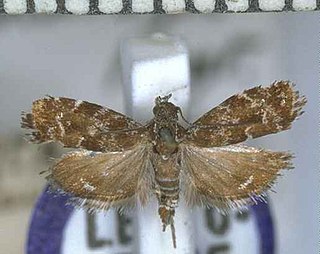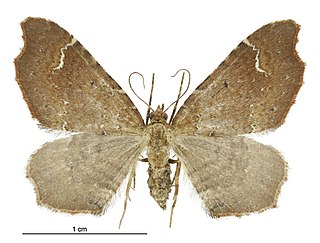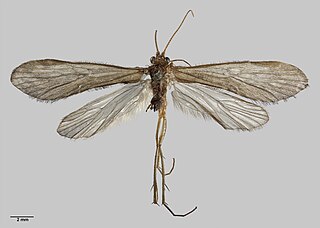
Asterivora analoga is a moth of the family Choreutidae. It is endemic to New Zealand and has been observed in both the North and South Islands. Adults are on the wing in December and January.

Heterocrossa eriphylla, also known as the lichen snoutlet moth, is a species of moth in the family Carposinidae. It is endemic to New Zealand and is found in the North Island and the northern parts of the South Island. This species is regarded as relatively uncommon and inhabits native forest. The larvae feed on the healing wounds of New Zealand beech trees Fuscospora fusca and Fuscospora truncata. It pupates at its feeding site and emerges from December onward. The adult moth is nocturnal and is attracted to light. During the day the moth rests on lichen covered tree trunks where their lichen mimicking colouration assists with their camouflage.

Asaphodes camelias is a species of moth in the family Geometridae. It is endemic to New Zealand, has been observed in both the North and South Islands and inhabits native forest. The adults of this species are on the wing from February to May and July to September.
Alloecentrella magnicornis is a species of caddisfly belonging to the order Trichoptera. The species was first described by Keith Arthur John Wise in 1958, and is endemic to New Zealand.

Diplectrona bulla is a species of caddisfly belonging to the order Hydropsychidae. The species was first described by Keith Arthur John Wise in 1958, and is endemic to New Zealand.

Ecnomina zealandica is a species of caddisfly belonging to the family Ecnomidae. The species was first described by Keith Arthur John Wise in 1958, and is endemic to New Zealand.

Hydrobiosis falcis is a species of caddisfly belonging to the family Hydrobiosidae. The species was first described by Keith Arthur John Wise in 1958, and is endemic to New Zealand.

Neobiosella is a monotypic genus of caddisfly belonging to the family Philopotamidae. The sole species found in this genus is Neobiosella irrorata. Both the genus and species were first described by Keith Arthur John Wise in 1958. Neobiosella is endemic to New Zealand.

Oeconesus lobatus is a species of caddisfly belonging to the family Hydrobiosidae. The species was first described by Keith Arthur John Wise in 1958, and is endemic to New Zealand.

Pseudoeconesus bistirpis is a species of caddisfly belonging to the family Hydrobiosidae. The species was first described by Keith Arthur John Wise in 1958, and is endemic to New Zealand.

Olinga is a genus of caddisflies belonging to the family Oeconesidae. The genus was described by Robert McLachlan in 1868, revising the genus name in 1894. All known species of Olinga are endemic to New Zealand.

Pycnocentrodes aeris, also known as the common stony-cased caddisfly, is a species of caddisfly belonging to the family Conoesucidae. The species was first described by Keith Arthur John Wise in 1958, and is endemic to New Zealand.
Confluens is a genus of caddisflies belonging to the family Oeconesidae. The genus was described by Keith Arthur John Wise in 1962, after noticing differences in two species previously placed within the genus Pycnocentrodes. Both species of Confluens are endemic to New Zealand.
Polyplectropus impluvii is a species of caddisfly belonging to the family Polycentropodidae. The species was first described by Keith Arthur John Wise in 1962, and is endemic to New Zealand.
Polyplectropus waitakerensis is a species of caddisfly belonging to the family Polycentropodidae. The species was first described by Keith Arthur John Wise in 1962, and is endemic to New Zealand.
Orthopsyche thomasi is a species of caddisfly belonging to the family Hydropsychidae. The species was first described by Keith Arthur John Wise in 1962, and is endemic to New Zealand.

Costachorema notopterum is a species of caddisfly belonging to the family Hydrobiosidae. The species was first described by Keith Arthur John Wise in 1972, and is endemic to the Auckland Islands of New Zealand.
Tiphobiosis kuscheli is a species of caddisfly belonging to the family Hydrobiosidae. The species was first described by Keith Arthur John Wise in 1972, and is endemic to the Auckland Islands of New Zealand.

Psilochorema embersoni is a species of caddisfly belonging to the family Hydrobiosidae. The species was first described by Keith Arthur John Wise in 1982, and is endemic to New Zealand.

Edpercivalia harrisoni is a species of caddisfly belonging to the family Hydrobiosidae. The species was first described by Keith Arthur John Wise in 1982, and is endemic to New Zealand.















